#ossicles
Explore tagged Tumblr posts
Text
Auditory Ossicles Osteology Notes
0 notes
Text
#7092
Come to the great witches' circle To witness a wondrous miracle From the horned god's ossicle.
1 note
·
View note
Text
I love you naturally colored gummy bears. I love you naturally colored popsicles.
#I'm allergic to a food color#I'm salty about it#what does blue gatorade even taste like?#And why does my spell check want me to change popsicles to ossicles?
0 notes
Text
am i allowed to google ‘where to buy real human bones’ or will i be put on a list
0 notes
Text
Wet Beast Wednesday: channel catfish
I like cats and I like fish, so it's a bit silly that I haven't done a WBW on catfish yet. Time to fix that. The channel catfish may not be the most spectacular of all catfish, but it's a skilled survivor and a tenacious little fish worthy of respect.

(Image: a channel catfish swimming in clear water. It is a long fish woth a round body and a broad, flat head. The fins are rounded and the anal fin is long and runs under the back half of the body. A fleshy adipose fin is on the top of the tail. The eyes are round and protrude from the head. Four pairs of barbels grow from around the mouth, the the largest extending from the upper lip. The body is a murky brown, with a white underbelly. End ID)
The majority of channel catfish (Ictalurus punctatus) reach 30 to 60 cm (1-2 ft) in length and weigh between 1 and 2 kg (2-4 lbs), but they grow throughout their lives and can occasionally get much larger. The world record channel catfish weighed 58 lbs (26 kg). Channel cats possess traits typical of catfish. The bodies are cylindrical and scaleless and four pairs of long, sensory barbels grow from around the mouth. The pectoral and dorsal fins have spines that are filled with venom which can cause stinging and numbness in humans. I know this from personal experience.

(Image: a channel catfish swimming over rocky substrate in murky water. End ID)
Channel catfish are heavily adapted to live in low-visibility environments by heavily focusing on senses other than sight. They have a powerful sense of smell thanks to heavily packed olfactory receptors in their nostrils. A channel cat can smell amino acids at concentrations of 1 part per 100 million. In addition to their mouths, channel catfish also have taste buds covering their skin, essentially turning their bodies into one big tongue. The taste buds are most concentrated on the barbels, which the catfish uses to help detect sources of food. Catfish hearing is enhanced by the presence of a Weberian apparatus, a complex system of bone and ossicles that connects the auditory system to the swim bladder. This allows the swim bladder to amplify vibrations, allowing sounds too quiet for the inner ear to normally detect to become audible.

Pogfish (Image: a channel catfish with mouth open, about to bite onto a baited hook. End ID)
Channel catfish are found in the eastern half of North America from Canada to northeastern Mexico. They can tolerate salt and brackish water, but are mostly found in freshwater, where they can inhabit everything from crystal-clear streams to murky lakes. While channel cats are omnivorous, they are specialized to act as predators in murky water. They are nocturnal ambush predators who retreat to deep water in the day and move to shallower water to hunt at night. They will either sit still and wait for prey to pass or slowly search through rugged areas, using their barbels to investigate crevices where prey could hide. Their nostrils and taste buds help finding prey, specifically by detecting the amino acids L-alanine and L-arganine, which are shed by animals. When catfish detect amino acids, they have been observed getting excited: turning, biting, and maneuvering themselves toward prey. As with other catfish, they rapidly open their mouths to create suction and force prey inside, where it is swallowed whole. Catfish will eat just about anything they can find, including small fish, various invertebrates, snakes, amphibians, insects, small mammals and birds, algae, seeds, nuts, and other plant material. Their diet becomes more carnivorous as they get older. Channel catfish are not social outside of mating and establish territories. They appear to follow a dominance hierarchy with larger animals claiming better territories and fighting to maintain them.

(Image: a channel catfish swimming amongst rocks. End ID)
Channel catfish have a complex system of communication using both chemical and auditory cues. Catfish in general can produce pheromones that can be used to recognize other specific individuals. They use these to advertise their presence to each other and mark their territory. Channel catfish can use pheromones to determine the sex, age, and size of another member of their species without ever actually encountering them and can differentiate between other species of catfish that share their habitat. When a channel cat detects another in its territory, it can mark its territory by altering its scent through a chemical change in the composition of the amino acids in its mucus. This scent does not linger long and is used as a challenge to the intruder, telling it to either leave or be prepared to fight. The change in scent may be regulated by club cells, specialized pheromone-producing cells found in the skin. The cells don't directly open to the water. It is hypothesized that injury may expose the club cells and cause them to release their contents. This would inform other catfish in the area of the injury, which could lead to a change in the local dominance hierarchy. Sound is produced through stridulation: clicking and grinding the bones of the pectoral girdle and the spine that leads the pectoral fins. By moving the base of the spine over the pectoral girdle, the fish can make a variety of noises. These noises vary in based on the movement of the fin and based on size and possibly sex, allowing channel catfish to learn about others that they hear. Channel cats will use noises to communicate dominance with each other and to startle predators, allowing for an escape while alerting any other catfish in the area of the predator's presence. If you've every caught a catfish and heard it make a croaking noise, now you know what's happening. Curiously, individual channel catfish will have a preference for which fin they use to make noise, with the majority favoring their right fin. This could be analogous to right and left handedness in humans.
youtube
(Video: a catfish that has been caught by an angler. It is being held by a tool and is making croaking noises. End ID)
Channel catfish spawn in spring and summer, when the water is consistently warm. Males will look for a cavity of some kind, which could be a crevice in rocks, a bank underhand, a spot beneath a log or other structure, or artificial objects like the inside of litter. He will clean the area of silt and mud to expose a hard bottom and then release pheromones to attract a female. Other males may attempt to drive him from his nest to claim it for themselves, leading to fights. When a female is interested, the two will enter the nest and remain there for up to 6 hours as eggs are laid. Females can release 2,000 to 4,000 eggs per pound of her weight and will do so in batches, with the male fertilizing them as they are laid. The eggs are yellowish and stick to hard surfaces. Once the eggs are laid, the male will chase the female from the nest and guard the eggs until they hatch. Until then, he will fan the eggs with his tail to keep oxygenated flowing over them and aggressively attack any perceived threat. Channel catfish in the wild only mate once per year, though males raised in captivity may attempt multiple matings. Larvae are hatched with the egg sac still attacked and survive on yolk for a few days until it falls off. After that, they have an algae-based diet that will gradually shift to carnivory as they age. Young channel catfish are a yellowish-brown with dark spots along the body while adults are a muddy brown all over.

(Image: a juvenile channel catfish held by me. It is a miniature version of an adult, with proportionately longer barbels and eyes. The body is a yellowish color. It is smaller than the thumb in the image. End ID
Channel catfish are classified as least concern by the IUCN, meaning they are not in danger of extinction. Channel catfish are the most widely distributed and populous catfish in North America. In the USA, channel catfish are a major food source and the channel catfish aquaculture industry is the largest aquaculture in the country. Channel catfish are raised in artificial ponds or other structures and are usually harvested for their meat at two years old. That's a lot for an animal that tastes like congealed air. Channel catfish are also a popular sport fish for their edibility and the fight they put up when hooked. Their use as food and for sport is a major reason for their introduction outside of their range. This has led to them becoming an invasive species in multiple countries, where they outcompete native species.

(Image: a POV shot of someone wearing rubber waders holding a channel catfish just above the water. End ID)
#wet beast wednesday#channel catfish#catfish#fish#bony fish#fishposting#fishblr#freshwater fish#biology#ecology#zoology#animal facts#informative#educational#image described#Youtube
88 notes
·
View notes
Text
Round 1 - Phylum Echinodermata




(Sources - 1, 2, 3, 4)
Echinodermata is a phylum of animals which are bilaterally symmetrical as larvae but radially symmetrical as adults. It includes starfish, brittle stars, sea urchins, sand dollars, sea cucumbers, and sea lilies.
Echinodermata is the largest marine-only phylum, and echinoderms can be found at every ocean depth from the intertidal zone to the abyssal zone. They make up a large portion of life in the deep sea. They are diverse, with some being sessile (lacking self-locomotion) while others are motile (able to move independently). Many are restricted to crawling slowly across the sea floor, while some can swim through the water column. They have a skeleton beneath their outer layer of skin, which is composed of calcite-based plates called ossicles. This would be heavy if it was solid, so it is instead porous. The ossicles may be fused together or articulated, and may have external projections such as warts or spikes. Echinoderms are often brightly-colored, and some of their pigment cells may even be light-sensitive, causing many echinoderms to change appearance completely as night falls. Their diet varies, with some species being predators, some being filter-feeders, some being herbivores, some only eating algae, and some being detritivores. Some injest food through a mouth and expell waste through an anus, while others can only expell waste back through their mouth. The ventral side of many echinoderms is covered in tube feet, each of which typically end in a suction cup pad. They primarily use their tube feet for movement, though some sea urchins will also “walk” with their spines.
Almost all species have males and females, though some are hermaphroditic and at least one reproduces by parthenogenesis. Eggs and sperm are released into open water, where they are fertilized externally. Some species may aggregate during reproductive season to increase the likelihood of fertilization. A small handful of species have internal fertilization. Some echinoderms, especially in colder areas, brood and carry their eggs until they hatch. Echinoderm larvae are usually planktonic, swim via cilia, and have bilateral symmetry. During metamorphosis, the left side of their body grows at the expense of the right side, which is eventually absorbed, ending with the body arranged in five parts around a central axis. Some species reproduce asexually. They do this by splitting in two, like a cell, and generating a new body half from the old one. Some larvae may also reproduce by budding.
The first echinoderms appeared in the Early Cambrian.

Propaganda under the cut:
Echinoderms are able to regenerate tissue, limbs, organs, and sometimes full bodies from a remaining portion of limb. Starfish and brittle stars may detach an arm as a defense mechanism, swimming away while a predator is distracted by the wiggling limb. Some sea cucumbers, on the other hand, take this to the extreme by expelling their cuvierian tubules (respiratory tubes) to entangle potential predators. Sometimes this is also accompanied by a discharge of toxic holothurin. It can take 1.5 - 5 weeks for the tubules to regenerate, depending on species.
The hard endoskeletons of dead echinoderms are geologicallly important, contributing to limestone formations.
Echinoderms sequester about 0.1 gigatonnes of carbon dioxide per year as calcium carbonate, making them important contributors in the global carbon cycle.
Sea stars are heavily muscled, and are able to go from soft to rigid in order to pull open the shells of their mollusc prey.
Sea urchins are among the main herbivores in reefs and there is usually a fine balance between the urchins and the kelp and other algae on which they graze. In the past, mass mortalities of sea urchins have led to algae blooms.
Some sea cucumbers have webbed swimming structures that allow them to swim freely through the water column. Pelagothuria natatrix (seen below) is the only truly pelagic echinoderm known so far.

(source)
Echinoderms seem to have an innate internal clock. Even at the depths of the ocean where no light penetrates, they are still able to synchronize their reproductive activity.
We don’t know much about Sea Pigs (Scotoplanes globosa) (seen in gif) other than that they’re poisonous sea cucumbers that feed on detritus at the sea floor. But we do know that they are often seen clutching young king crabs (Neolithodes diomedea) and carrying them around. One possible theory is that these crabs latch onto S. globosa to gain access to nutrients and movement, and sheltering beneath the poisonous sea pig allows them to hide from predators. As sea pigs are sometimes plagued with parasites that bore holes into their bodies, the crabs may also help the sea pigs by keeping them clean of parasites. For now, all possibilities are just hypotheses, but we can stil Awww at the globby pink sea cucumbers cuddling their little pet crabs.
Along with Hemichordata, they are the closest relatives of Chordata (aka our phylum!)
Some sea urchins pick up rocks, shells, and other debris and carry them around to shade themselves from the sun. Some people who keep them as pets have come up with creative ways to allow them to do this without dismantling the architecture:

(source)
Silly hats aside, these seemingly simple animals are using tools.
123 notes
·
View notes
Text


I have a big announcement!! Me and @/OsSiCl (on Twitter) have been working in the shadows on a big Zelda Fan-Project for a while now, but now it’s finally time to introduce it to you all!
I present to you: Cerulean Blues, a Botw Fancomic!
The Pilot Chapter is coming out soon!!! You can follow the updates on @cerulean-blues-botw-au

Shoutout to the literal 3 people behind this project, including meeee :333 no but for real. My sister, Sugo, and my friend Ani have been AMAZING cowriters and have cooked a lot!!!
We’ll release more details once we have a date for the release of our chapter zero!!
#legend of zelda#zelda#botw#loz botw#breath of the wild#fan comic#my au#my comic#ceruleanblues#ceruleanbluesau#botw link#urbosa#revali#daruk#mipha#botw zelda
44 notes
·
View notes
Text
Fossil Friday: Sea Stars

The oldest star fish fossils are dated back to the middle Ordovician of Alabama.

This is the Alabamian specimen, Schuchertia, a carnivorous sea star. It is approximately 450 million years old.
Starfish are part of an invertebrate group known as the echinoderms which means "hedgehog skin". Echinoderms include :

Star fish specifically belong to the class Asteroidea (means like stars). Their fossil record is sparse because they tend to break apart before fossilization. Most of the time we only find the ossicles, small calcareous bits embedded in the dermis.

The larvae of echinoderms have bilateral symmetry, but during metamorphosis this is replaced with radial symmetry, typically pentameric.

Adult echinoderms are characterized by having a water vascular system with external tube feet


and a calcareous endoskeleton consisting of ossicles connected by a mesh of collagen fibers. Starfish are included in the subphylum Asterozoa, the characteristics of which include a flattened, star-shaped body as adults consisting of a central disc and multiple radiating arms.
There are over 1900 living species in seven orders and an estimated 1200 extinct species (again, hard to know since they disintegrate after death).

Brisingida: Species in this order have a small, inflexible disc and 6–20 long, thin arms, which they use for suspension feeding. They have a single series of marginal plates, a fused ring of disc plates, a reduced number of aboral plates, crossed pedicellariae, and several series of long spines on the arms. They live almost exclusively in deep-sea habitats, although a few live in shallow waters in the Antarctic.

Forcipulatida: Species in this order have distinctive pedicellariae, consisting of a short stalk with three skeletal ossicles. They tend to have robust bodies and have tube feet with flat-tipped suckers usually arranged in four rows.

Notomyotida: These starfish are deep-sea dwelling and have particularly flexible arms. The inner dorso-lateral surfaces of the arms contain characteristic longitudinal muscle bands.

Paxillosida: This is a primitive order and members do not extrude their stomach when feeding, lack an anus and have no suckers on their tube feet. Perhaps some of our extinct friends belong in this order?

Spinulosida: Most species in this order lack pedicellariae and all have a delicate skeletal arrangement with small or no marginal plates on the disc and arms. They have numerous groups of short spines on the aboral surface.

Valvatida: Most species in this order have five arms and two rows of tube feet with suckers. There are conspicuous marginal plates on the arms and disc.

Velatida: This order of starfish consists mostly of deep-sea and other cold-water starfish often with a global distribution. The shape is pentagonal or star-shaped with five to fifteen arms. They mostly have poorly developed skeletons with papulae widely distributed on the aboral surface and often spiny pedicellariae.
Fun fact about starfish and other echinoderms; they are actually more closely related to us than to other invertebrates. Wild right?

Maybe one day we'll be able to learn more about fossil starfish. Until then, tune in Monday to learn about the Hirnantian glaciation. Have a good weekend and fossilize you later!
23 notes
·
View notes
Note
(from wikipedia) The Malleus is a bone situated in the middle ear. It is the first of the three ossicles, and attached to the tympanic membrane. The head of the Malleus is the large protruding section, which attaches to the incus. The head connects to the neck of Malleus. The bone continues as the handle (or manubrium) of Malleus, which connects to the tympanic membrane. Between the neck and handle of the Malleus, lateral and anterior processes emerge from the bone. The bone is oriented so that
Omg, malleus (hammer)-sama real? 😱
This interaction is vaguely inspired by a really romantically charged wall slamming scene in a K-drama I’ve recently been watching—
Like Fire, Hellfire.
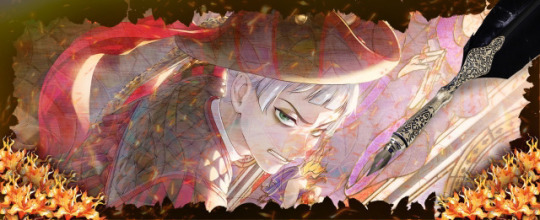
You ran a finger along the next line of the anatomy and physiology textbook in your hands, reciting the words aloud. The chapter was on hearing and the various components of the human ear. You stressed malleus loudly each time the bone came up, grinning madly all the while.
Beside you, Rollo paused in rifling through the bookshelf and shot you a sideways stink eye. He had come the school archives in search of knowledge, not annoyance—yet here you were, acutely aware of how to get under his skin, and doing an excellent job of it.
What an irksome individual.
Handkerchief to his face, Rollo snidely asked, “… Are you quite finished?”
“No, never,” you gasped, innocently batting your lashes at him. (Rollo’s left eye twitched.) “A good student is always on a quest for new wisdom, so I have to study up on the malleus while I still can.”
“At least read it to yourself quietly; this is a library, not a concert grounds. You are so rudely disrupting the concentration of your peers.”
Namely, myself.
He didn’t want to confess it—certainly not out loud—but you had been distracting him ever since you first stepped into the room. Rollo had stole several suspicious looks at you since, glances he justified to himself with, What must they be up to now?
Your goofy grin, your earnest and open heart. They all put him on edge, set the beat to his heart at a rapid, uneasy hammer.
A minion of evil, come to ensnare him into committing vices.
Rollo took a sharp breath to calm himself.
“They can learn about the malleus too,” you said, flipping to the next page. “I’m a free educational audiobook.”
“Then pick something else to blather on about,” Rollo insisted sharply.
“What, do you have something against the malleus?“
His face heated with fury, eyes flashing dangerously. If I hear that man’s name on your lips one more time, my head is going to explode.
“Just tell me your true feelings then,” you urged with a pout. “Tell me how you feel about the mal…”
He moved before you had even registered it. His hand was on your book, shunted shut with a CLAP!! You squeaked, leaping desperately for it—but a tall shadow had fallen into your path.
SLAM!!
A fist came down hard beside you, walling you in between a livid Rollo Flamme and the bookcase to your back. He glared down at you, face twisting with disdain. Gone was his neutral expression, replaced with cruel eyes and a cold, creased scowl.
You gulped, suddenly feeling like a mouse caught in a trap.
“You would do well to listen and be obedient,” he hissed darkly. “Do not speak his name, for you will summon him like the demon he is.”
The only name you should be speaking is…
He banished the blasphemous line from his head. Cursed it, damned it to hell.
Rollo tore the book from your hold and abruptly stepped away. He still hummed with warmth—an exhilarating blend of rage, envy, and, most disgusting of all, desire. Hot, burning, hungry.
He hurriedly stamped it out as though it were an item unintentionally set ablaze. Stuffed it in an ash pile, along with everything else burnt away to black. Happiness, hope.
Love.
“… I will be returning this to its rightful place,” he spat out. “While I am gone, you should reflect on your actions and repent.”
Rollo didn’t wait for a response—he was already gone before you could reach for him.
A hand of acceptance, rejected before it had even been offered.
#twst x reader#twst#twisted wonderland#Rollo Flamme x Reader#Rollo Flamme#twst interactions#twisted wonderland interactions#disney twisted wonderland#Reader#self insert#Rollo at the Writing Desk
171 notes
·
View notes
Text
Phylum #6: Echinodermata!

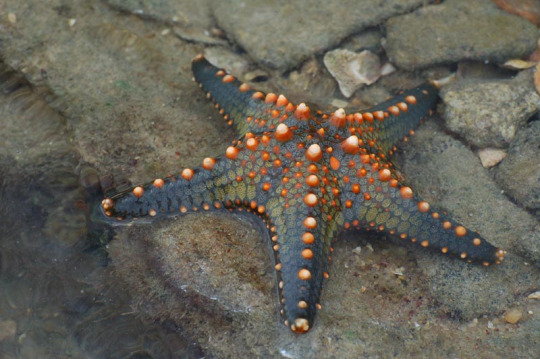
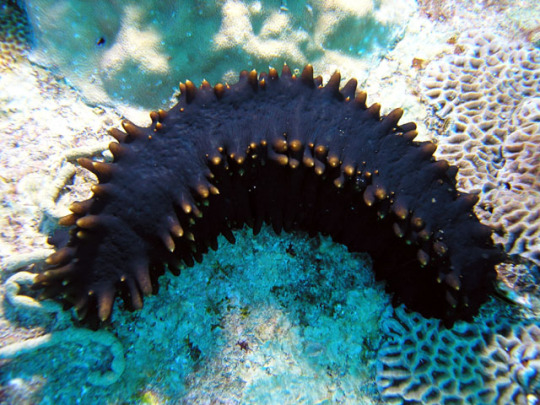
Starfish! And sea urchins, sea cucumbers and other little creatures! All of them are united by having a hard skeleton made of tiny elements called ossicles. They also have hundreds of little tube feet, powered by a entirely water pressure-based vascular system!
They're also pretty unique among bilaterians for having switched their usual bilateral symmetry for a five-way one (yes, urchins have a five-pointed star under their spikes!). Even weirder, some of them like sand dollars and sea cucumbers switched again, and got their bilateral symmetry back!
Most echinoderms are pretty familiar, but some can take on pretty unique shapes. Crinoids are filter-feeders shaped like large feathered tufts - some fixed on a stalk, while other can walk or even swim by themselves, undulating through the ocean. Until the Jurassic, reefs and rafts of crinoids floating on driftwood were extremely common, at the heart of most marine ecosystems!
Sea cucumbers are also known to exhibit quite interesting forms among echinoderms, with Pelagothuria being nearly jellyfish-like in appearance!
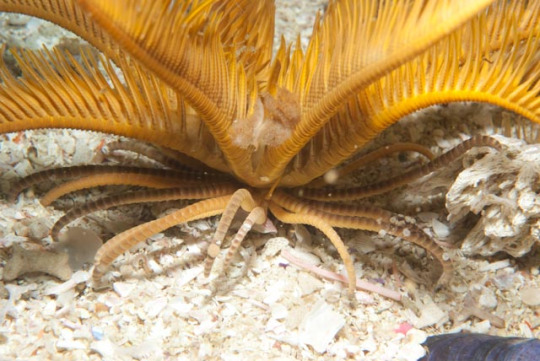

#forms and phyla#echinodermata#starfish#brittle star#sea urchin#sea cucumber#sea lily#crinoid#sea life#sea creatures#marine life#marine biology
267 notes
·
View notes
Note
am also a big fan of delving in a fandom via fic before even finishing the canon material if I enjoy the characters and worldbuilding enough. Curious to see which fics convinced you to read more if you feel luke sharing any! 💛 loving your one piece posting and hope you are doing well!
Fic rec time! They're all from the same author (Ossicle) I love them. Just very, very good writing. All of these are 18+ and the pairing is Kid/Law.
First one is Selkie Skin. It's dark fantasy set by a cold coast in an undefined past. Law is a leopard seal selkie in deep trouble. Kid is a miserable village misfit who finds him injured on the beach and decides to take his Skin. They're both teens in this one, 15-16. It's a very sweet love story in a rather brutal setting and a great mix of hurt and comfort. There are horrors but nothing too explicitly awful. Still mind the tags and chapter warnings. Rated E.
Then there's Pit Town Strays. The apt summary goes: "Kidlaw softness and redneck shenanigans in a northern mining town. Everything's fucked but whatever." Law is a struggling med student with a messed up family. He takes a random job as babysitter and meets lovably messy mechanic Kid and his toddler sister Nami. Cute and wholesome at points but everything really is fucked and Law is not ok. It's rated M so they're not super fucked though.
Halogen Heart is a modern AU soulmates fic where all the straw hats + Law and Kid live in a giant rickety house full of mismatched queer punks. Law is haunted by a creepy destructive relationship from his past and Kid is concerned while also dealing with chronic pain from losing his arm. There's dark magic stuff, angst, love and very creepy Doffy. Also fun descriptions of all the straw hats being various shades of queer punks! Rated M.
Ora Pro Nobis is where things get really fucked. Be very sure to read the tags and warnings on this one because it's dark and brutal and deals heavily with drugs, sexual abuse and just a bunch of really awful shit. It's so, so well written though. This was the first one I read and I could not make sense of how it's based on One Piece. Now I can see it, and it sort of makes some canon scenes feel much darker than they may have been intended to be. Anyway, it's a modern day mafia AU where Law is a heavily drug addicted assassin and Kid is the guy assigned to make sure he doesn't kill himself or his superiors. His superiors should definitely be killed though. So yeah, this is pitch black dark but the KidLaw pairing has it's own kind of sweetness and fun appearances of Law's crew members light things up.
Speaking of lighting things up:
I read Law and Chaos recently, since it's set in canon universe. It's got Kid and Law playing courtship mind games as captains, leaving bloody gifts to each other while their crew members are like "please stop". Just a bit of KidLaw smut with the fun and very enthusiastically consensual kind of violence. Nothing awful happens at all in this one.
#I should let the author know about this#because I'm a fan#and I've watched 600+ episodes of one piece because of their works#and I plan to let them know#I just want to make some fan art first <3#when I have time#fic rec#KidLaw#one piece
17 notes
·
View notes
Text
reminder to NOT SCREW UP AND WRITE "OCCLUPANIDS" INSTEAD OF "OSSICLES" ON YOUR BIOLOGY EXAM!!!! OCCLUPANIDS/ BREAD TAGS SHOULD *NOT* BE IN YOUR EARS!!!

9 notes
·
View notes
Note
(in an attempt to give Sans googly eyes)
BOO


(Good effort, but his ossicles are very sensitive, hehe.)
14 notes
·
View notes
Text
Wet Beast Wednesday: brittle stars
Some animals end up living in the shadows of others. Everyone knows about starfish, the famous branching echinoderms, and a lot of people know about brittle stars, but not as many people know that brittle stars aren't starfish, they're their own thing. But because they look similar, brittle stars are frequently mistaken for a type of starfish, rather than being recognized as their own animal. I aim to help these stars shine and be recognized as their own animal.
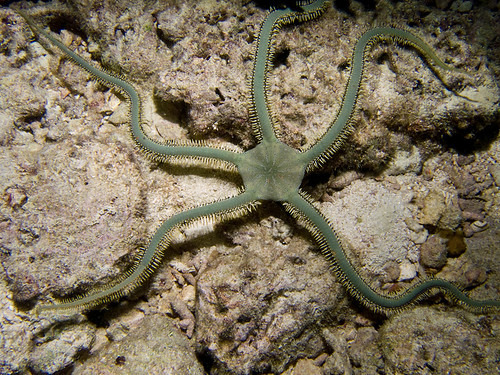
(Image ID: a green brittle star on a rock. It consists of a small, round central body with five long, slender arms arms emerging from it at equal distances from each other. Thea rams are lines on either side with small bristles. End ID)
Brittle stars are members of the class Ophiuroidea, which is closely related to Asteroidea, the true starfish. The name comes from the Greek "ophis", meaning "serpent", a reference to their long, skinny arms. Ophiuroidea is divided into two orders, Ophiurida (true brittle stars) and Euryalida (basket stars). As with all echinoderms, brittle stars are radially symmetrical, consisting of multiple body segments that radiate around a point, akin to the slices of a pizza. The majority of brittle star species have five segments, though a few have six or more. Similarly to starfish, brittle stars have their arms radiating out from a central disc. In brittle stars, all the organs are located in the disc and as long as the disc remains intact, the arms can be regrown. The mouth (which also functions as the anus) is located in the center of the disc and each body segment has a single jaw and tooth. Some starfish can regenerate into two animals if the disc is cut in half, but almost no brittle stars can survive being cut in half. That being said, some species can reproduce via fission, where the disc splits in half and each half regenerates into a fully-grown star. In brittle stars, the arms are narrower than the disc, making the disc much more visually distinct than in starfish, where it can be hard to tell where the disc ends and arm begins. The arms of a brittle star are slender and highly flexible. When in danger, a brittle star can sever one of its arms. This is usually done in response to predation, in hopes that a predator will opt to eat the arm while the star makes its escape. This is called autotomy and is the reason why the common name of these animals is brittle star. The arms are formed of multiple calcium carbonate plates called vertebral ossicles due to their resemblance to vertebrae. The ossicles are connected to each other by ball and socket joints, allowing for a great degree of flexibility. Most true brittle stars can flex their arms side to side, but not up and down, while basket stars can flex in all directions. In basket stars, the arms branch multiple times. Unlike starfish, brittle stars use their arms for locomotion. The arms move in a rowing motion to drag the star around. Some species can swim for short distances as well. By contrast, starfish (and urchins) move using tube feet. Tube feet are a common echinoderm trait and consist of small tubes with a sucker on one end that are inflated and moved with water pressure. Most echinoderms use their tube feet for movement and feeding. True brittle stars, by contrast, seem to use their tube feet primarily for sensory reception, though they are also used to help transport food to the mouth. Due to moving with their arms instead of tube feet, brittle stars are capable of much faster movement than starfish, though in short bursts. Like other echinoderms, brittle stars use a water vascular system, where water is drawn into the body and used to inflate and move the tube feet and as a substitute for blood. Brittle star reproduction is fairly standard for echinoderms. The males and females will release their gametes into the water column. Fertilized eggs develop into pluteus larvae, which swim using cilia. In the pluetus stage, echinoderms are bilaterally symmetrical. They become radially symmetrical during metamorphosis into the juvenile form.
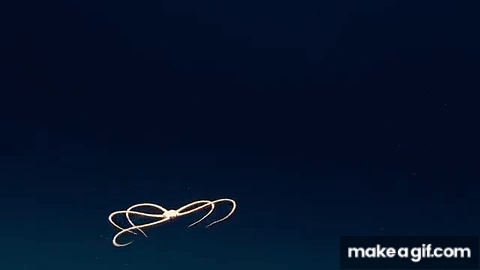
(GIF ID. A pale white brittle star swimming by rapidly moving its legs. End ID).
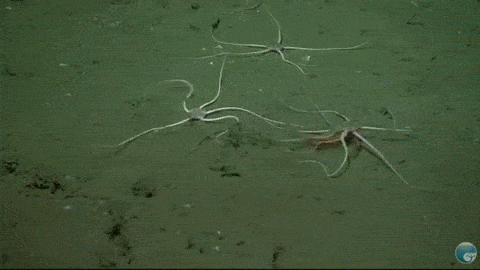
(GIF ID: two white brittle stars (with a third in the background) moving across sand by using their legs to push and drag themselves along. One appears to be carrying a red object in its mouth. End ID)
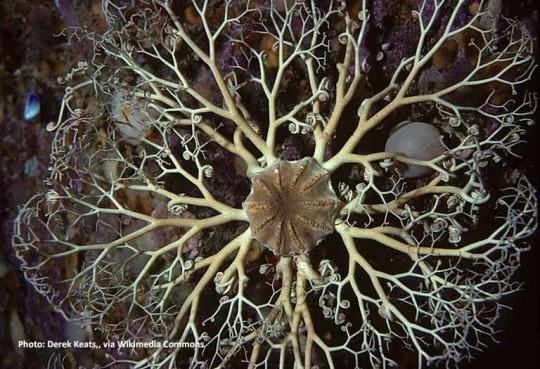
(Image ID: a basket star on a rock. The central disc in brown and has a pair of arms emerging from each segment. Each arm branches repeatedly and those branches have their own branches, resulting in a vaguely bush-like appearance. End ID)
Brittle stars are eyeless, but can detect light. Most animals, and a lot of non-animals, have some ability to detect the presence or absence of light. True vision, the ability to form images, requires more complex systems than the might-sensing cells most animals have. More specifically, it requires an eye. Or at least that's what we thought until scientists found evidence that the brittle star Ophiomastix wendtii may be able to form imaged without an eye by using its whole body as one big eye (a sea urchin, Diadema africanum) also seems to have this ability). Brittle stars are covered with light-sensing structures called opsins that can detect the presence or absence of light, but vision-forming sight requires the ability to determine how much light is coming from what direction. O. wendtii uses chromatophores to alter its color and these packets of pigment-changing cells are arranged in such a way that they may provide that directionality. In tests, O. wendtii would travel to shelter when exposed to light with a greater than change likelihood while the closely-related O. pumila would move at random when exposed to light. O. pumila lacks the types of pigment that O. wendti has, which could prevent it from being able to form the directionality needed for vision-forming sight. This is reflected in the species' behavior. O. wendtii moved toward shelter when exposed while O. pumila prefers to bury itself. The possibility for vision to exist without eyes means that a lot of animals we previously thought of as blind may actually be able to see, though probably not as well as animals with eyes.
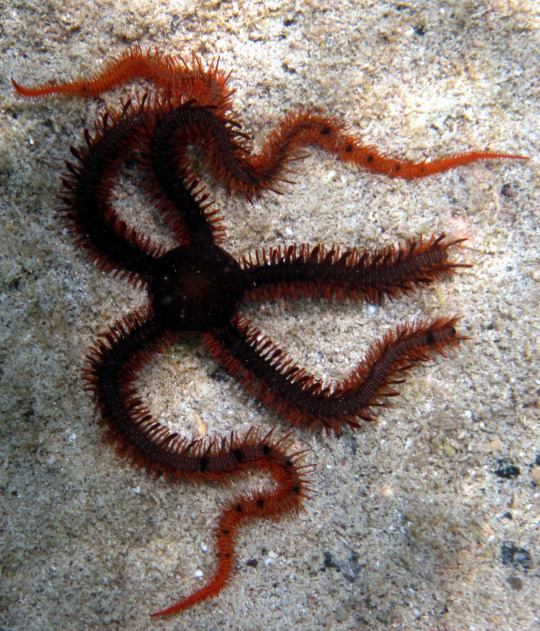
(Image ID: Ophiomastix wendtii, a red brittle star with larger bristles on its legs. Two legs are shorter and blunted, possibly having been damaged. End ID)
There are over 2,000 known species of brittle star that live all over the oceans, from shallow water to the deep sea. Most basket stars are seep-sea animals, though some shallow-water species are known. True brittle stars are mostly detritivores who crawl along sediment and eat bits of organic matter and tiny organisms. This behavior makes them seafloor engineers. Their feeding behavior stirs up the sediment, releasing nutrients and affecting the behavior of other species that rely on the sediment. Because of this, brittle stars are often highly important parts of their ecosystems. Some species follow different lifestyles. Some will target and eat sponges or coral polyps while others are active predators of small animals, filter feeders, or even omnivores that eat plant matter. Brittle stars often live in or on corals or sponges, which provide a source of protection. The relationship between star and coral or sponge may be symbiotic in some species, with the star eating parasites and pests that endanger its host. Basket stars are filter feeders that use their many branching arms to catch plankton. They need to live in places with a current as as such are often foudn on seamounts, where the underwater mountain directs the flow of water into currents. The star anchors itself to a rock, coral, or other surface and extends its arms into the current to make a net. The arms are lined with tiny hooks that catch plankton carried by the flowing water. Once caught, tube feet cover the plankton with mucus and transport it slowly to the mouth. The star will sometimes bring its arms to its mouth to speed up the process. When threatened, basket stars will bring in their legs and form a ball to protect the disc. Basket star arms are less muscular than those of true brittle stars and therefore they are not as fast. Basket stars generally get bigger than true brittle stars, with the largest species, Gorgonocephalus eucnemis, having a disc up to 14 cm (5.5 in) in diameter and an arm length of up to 70 cm (27.5 in).
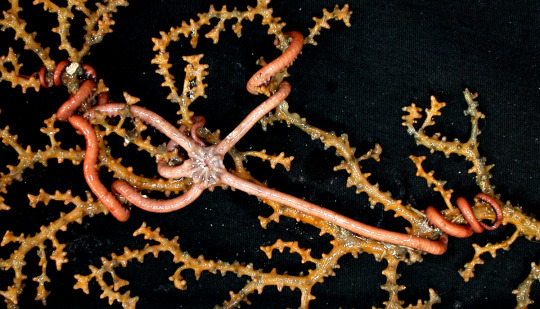
(Image ID: a pale red brittle star with no bristles on its arms. It is climbing sea fan (type of coral with appearance similar to a fern), with its arms wrapped around the coral for stability. End ID)
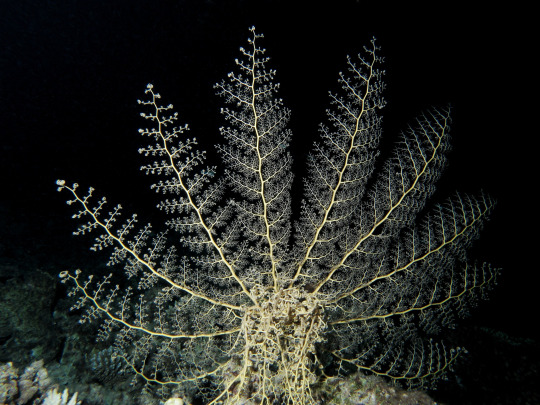
(Image ID: a basket star in feeding posture. It is on a rock with some of its arms used to support it. The rest of the arms are extended into the water column, with every branch fully extended. It looks kind of like pale white ferns. End ID).
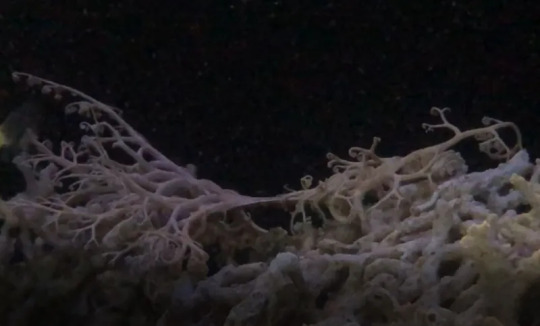
This basket star living in the St. Lucie County Aquarium in Ft. Pierce, Florida ripped itself in half shortly after being introduced to the exhibit. Esch half survived and regenerated into a full basket star. This is the only time this behavior has been seen in this species (Astrophytum muricatum). Of course, trying to rip yourself in half is a reasonable response to realizing you have to live in Florida.
(Image ID: a white basket star splitting into two halves, each with a portion of the arms. The only thing connecting the halves is a small strip of tissue. End ID)
#wet beast wednesday#brittle stars#basket stars#echinoderm#marine biology#marine life#animal facts#zoology#biology#ecology#pictures#image described
188 notes
·
View notes